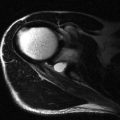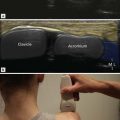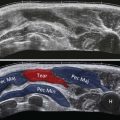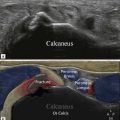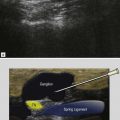Arm Anatomy
The anatomy of the arm is generally best understood by considering two compartments: flexor and extensor. In each, there are proximal and distal configurations roughly delimited by the level of the deltoid insertion on the lateral aspect of the mid humerus.
Position 1: Anterior Compartment Proximal
The neurovascular bundle on the medial aspect of the arm provides a useful landmark to begin to view the anatomy of the proximal arm. The bundle comprises the brachial artery and veins, with the median nerve anteriorly and ulnar nerve posteriorly ( Fig. 5.1 ). A number of smaller cutaneous nerves are all found here. The medial antebrachial nerve lies superficial and anterior while the medial brachial cutaneous nerve lies superficial and posterior. At a very high level, the radial nerve is also noted in this compartment, posterior to the brachial artery. It will soon pass into the posterior compartment as it traverses from medial to lateral posterior to the humerus. The coracobrachialis muscle is anterolateral to the bundle. High in the anterior compartment, well above the deltoid insertion, the pectoralis muscle and tendon is found as it passes to its insertion on the humerus. Deep to this are the two heads of biceps which overlie the coracobrachialis muscle ( Fig. 5.2 ). The other important nerve structure is the musculocutaneous nerve which passes through the coracobrachialis in its posterior portion to come to lie between this muscle and the overlying biceps.


The anterior compartment is separated from the posterior compartment by the tendinous insertion of the latissimus dorsi that lies posterior to the bundle in the upper arm. Immediately posterior to latissimus dorsi is the teres major. Teres major muscle forms the floor of the quadrilateral space as it passes anteriorly to insert on the anterior aspect of the humerus (as distinct from the teres minor muscle, which inserts on the posterior aspect).
Position 2: Anterior Compartment Distal
As the probe is passed a little more distally, the brachialis muscle that has an origin from the anteriolateral aspect of the humerus appears ( Fig. 5.3 ). As this muscle grows distally, the coracobrachialis diminishes towards its insertion medially. Below the insertion of the coracobrachialis, the biceps and brachialis muscles dominate the anterior compartment ( Fig. 5.4 ). At this level, the ulnar nerve has moved a little more posteriorly and is now often contained in a little pouch on the medial surface of the medial head of triceps ( Fig. 5.5 ). The median nerve maintains its relationship with the brachial artery. The musculocutaneous nerve emerges from coracobrachialis to lie between the biceps muscle anteriorly and the brachialis muscle posteriorly as it moves laterally.



Position 3: Posterior Compartment Proximal
The posterior compartment contains the three heads of triceps and deltoid. In the proximal arm, however, the medial head has yet to appear. The long head arises from the infraglenoid tubercle of the scapula. It forms the central third of the bulk of the extensor compartment. The lateral head also arises from the dorsal surface of the humerus. Proximally, the lateral relation of the triceps is the deltoid muscle, straddling both anterior and posterior compartments. The medial relation is the tendon of latissimus dorsi. The radial nerve passes below teres major and enters its groove on the posterior aspect of the humerus.
Position 4: Posterior Compartment Distal
The medial head of triceps has a much lower origin than the lateral or long head. It arises below the insertion of teres major, and just below the groove for the radial nerve. In the proximal arm, therefore, prior to the radial nerve passing posterior to the humerus, the muscle posterior to it is the long head, not the medial head. As the radial nerve emerges lateral to the humerus, all three muscles of the posterior compartment are present and visible ( Fig. 5.6 ). The radial nerve now lies lateral between the anterior and posterior compartments, that is, between the brachialis muscle anteriorly and the lateral head of triceps posteriorly, along with the posterior antebrachial cutaneous nerve.

As the radial nerve is followed distally, it passes around the lateral border of brachialis. As it does this, it gains two new lateral relations: the brachioradialis ( Fig. 5.7 ) first, then extensor carpi radialis longus as it gradually moves towards the anterior compartment. These two muscles of the forearm compartment are covered more fully in Chapter 10 .

The triceps tendon forms principally from the long head, but then quickly accepts the lateral head to insert on the posterior aspect of the olecranon. The musculotendinous junction of the medial head is much lower, with muscle fibres being traced to the olecranon.
Elbow Anatomy and Techniques
Due to its complex anatomy, the elbow joint is one of the more difficult joints to examine comprehensively with ultrasound. To make this easier, standard sections will be described using a regional approach. As patients often present with focal symptoms, this method is helpful in dealing with the most common clinical presentations.
Patient Position
The simplest method of evaluating the elbow is to have the patient seated opposite the examiner. In this position, the elbows can be extended across the examination couch and side-to-side comparison is straightforward. The lateral aspect of the elbow can be accessed by asking the patient to place their hands in the praying position. This internally rotates the elbows, bringing the common extensor origin (CEO) into view. The medial aspect of the elbow can be examined by asking the patient to tilt their shoulders to the affected side and supinate the elbow. The anterior aspect of the elbow is easily accessible. The posterior aspect can be approached by asking the patient to flex their elbow and internally rotate at the shoulder, placing the palm of their hand on the examination couch. This is the so-called ‘crab’ position.
Position Variations
Alternatively, the patient can lie on the examination couch with the affected arm to the side of the examiner. This position is a little bit easier for assessing the medial aspect of the elbow. The flexed elbow can also be drawn across the abdomen to allow access to the posterior aspect of the elbow. Additionally, this position is useful for following nerves that can be tracked from the brachial plexus to their terminal branches. The ulnar nerve in particular is easier to follow in this position, particularly in its course through the cubital tunnel. The recumbent position is also used for interventional procedures where there may be a risk of the patient fainting.
For children with elbow joint effusions, an option is to have the child sit on the parent’s lap, facing them with one knee on either side of the parent. The parent can cuddle the child whilst making the posterior aspect of the elbow available for ultrasound examination and aspiration.
Standard Position 1: Lateral Elbow
Imaging Goals
- 1.
Identify the components of the CEO.
- 2.
Identify radial collateral ligament (RCL) and associated meniscus.
- 3.
Identify and trace the important branches of the radial nerve.
Technique
The CEO lies beneath the two muscles that form the bulk of the proximal lateral part of the elbow. The anterior muscle is brachioradialis and the posterior is extensor carpi radialis longus. Deep to this is a fibrous conglomerate made up of the remaining tendons of the extensor compartment. This is the CEO. In many cases the individual tendons are difficult to separate but in some patients each component can be recognized. If an abnormality is present, the easiest method of identifying individual tendons is to begin more distally where the muscles have separated, even going as far as the wrist where the positions of the tendons make the individual components easiest to remember. Each muscle component can then be tracked proximally back to its origin. The anterior and deep part of the CEO is extensor carpi radialis brevis. This is the tendon most frequently involved with tennis elbow. Anterior and superficial is extensor digitorum, with extensor carpi ulnaris making up the posterior portion. The bulky muscle that lies posterior to the CEO is anconeus.
The lateral aspect of the elbow is examined in both its short and long axes ( Fig. 5.8 ). A good method for locating the common tendons is to place the probe first in the axial position on the lateral aspect of the distal arm above the epicondyle. The bony margin of the lateral humerus is followed distally until it dips sharply just below the epicondyle. The ‘space’ below the lateral epicondyle is filled by the CEO ( Fig. 5.9 ). The probe can then be turned 90° to demonstrate the common origin in long axis. In this orientation, the CEO is shaped like a long thin triangle with a striated, predominantly reflective structure. Under normal circumstances, there is only minimal Doppler signal present within it. With practice, this standard view of the tendon can be achieved easily.


